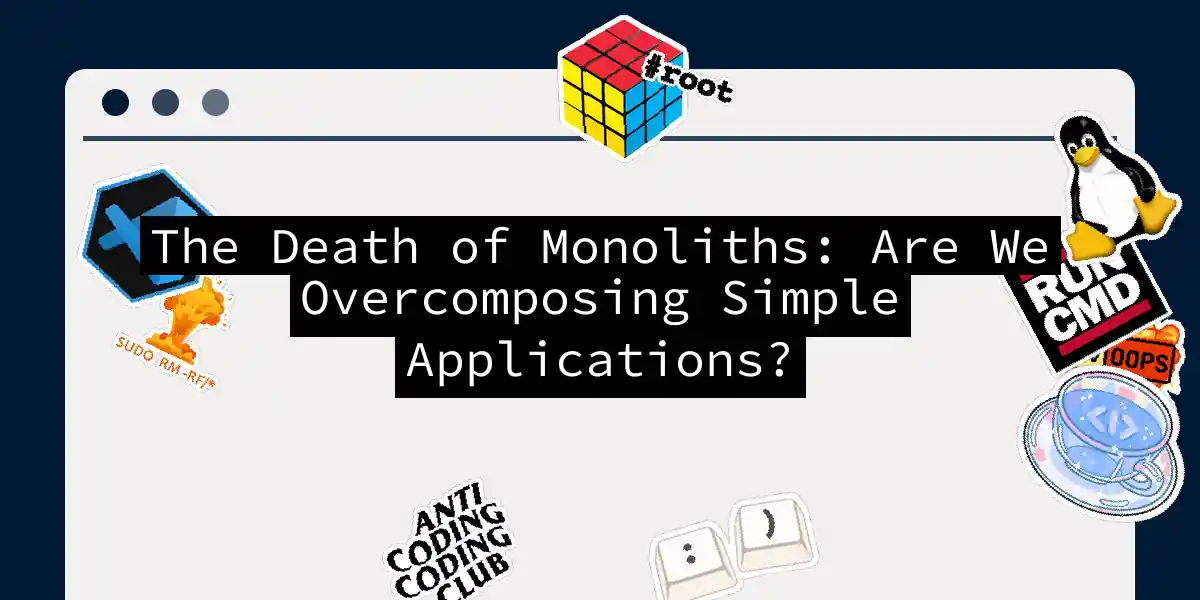Picture this: you’re building a doghouse. You grab some plywood, a saw, and nails. Suddenly your neighbor appears wearing architect glasses and a Kubernetes hoodie. “You should really use microservices for that,” he says. “Each leg could be an independent service!” We’ve reached peak “microservices everything” culture, and it’s time for an intervention.
Why We Fell in Love with Distribution
Let me tell you a story about my friend Dave. Dave made the perfect todo app - a single Python file that could:
# monolith.py
from flask import Flask
app = Flask(__name__)
todos = []
@app.route("/add/<item>")
def add(item):
todos.append(item)
return f"Added {item}!"
@app.route("/list")
def list_items():
return "<br>".join(todos)
if __name__ == "__main__":
app.run()
Then Dave discovered Docker. Suddenly his setup looked like this:
His cloud bill now exceeds his rent, but hey - at least he’s “cloud native”!
When Simple Becomes a Crime
The industry’s obsession with distributed systems has reached comic proportions. I recently saw a tutorial for “Microservices Hello World” requiring:
- Kubernetes cluster
- Istio service mesh
- 17 different YAML files
- A blood sacrifice to Martin Fowler
Let’s compare deployment complexity:
Operation Monolith Microservices Local Run python app.pydocker-compose upDebugging Print statements Distributed tracing Deployment SFTP + restart GitOps pipeline Team Size 1 developer 5+ SREs
The Swiss Army Knife vs The Toolbox
My hot take: Most applications should start as monoliths and earn their distribution through pain. Here’s my “Controversial” decision tree:
When to YOLO-lith:
- Prototyping
- Small teams (1-3 devs)
- Linear scaling needs
- “Just ship it” deadlines
When to Microservice:
- 10+ micro teams
- Independent scaling needs
- Multi-cloud deployments
- You enjoy writing YAML poetry
The Art of Strategic Monoliths
Let me show you how to build a “modular monolith” that doesn’t suck:
- Create clear bounded contexts
# project/
# auth/
# routes.py
# models.py
# todos/
# routes.py
# models.py
- Use dependency injection
class TodoService:
def __init__(self, db):
self.db = db
# In your route:
service = TodoService(Database())
- Enforce vertical slices
/user-auth
├── Dockerfile
├── requirements.txt
└── src/
/todo-management
├── Dockerfile
├── requirements.txt
└── src/
This gives you the optionality to split later without the upfront complexity tax.
The Hybrid Horcrux Approach
For those who can’t quit microservices cold turkey, try the “Horcrux Pattern”:
- Start with monolith
- Identify one volatile component
- Split it out as a service
- Repeat when justified Example evolution:
Phase 1: Monolith (User auth + Todos)
Phase 2: Monolith + Payment Service
Phase 3: Auth Service + Todos Monolith + Payments
Pro tip: Use this migration checklist:
- Business justification exists
- Team can handle cognitive load
- Monitoring is better than your ex’s Instagram stalking
- You know what a circuit breaker is (not the electrical kind)
Survival Tips for Distributed Systems
If you must microservice, avoid these rookie mistakes:
The 3AM Incident Test
Can you debug it while sleep-deprived with 2FA issues? No? Simplify.
The Petabyte Paradox
Are you handling Twitter-scale traffic? No? Maybe you don’t need 16 Redis clusters.
The Framework Carousel
Stop reinventing wheels. Use:
# For 90% of cases
docker compose up
# Instead of
kubectl apply -f orchestra-of-suffering.yaml
The Future is Boring (And That’s OK)
In 2025, the most radical choice is using the right tool for the job. Sometimes that’s a glorious monolith. Sometimes it’s strategic services. Always, it’s about business value over architectural fashion. As I tell my team: “If your architecture diagram needs a legend, you’re probably overcompensating.” Now go forth and build simple systems that make users happy - not just SREs employed. What’s your take? Have you seen microservices overkill in the wild? Share your horror stories @CodeMaxim #MonolithsLiveMatter
